Lower Back Strengthening Exercises


This series of lower back strengthening exercises will help you keep your back strong. Performing these types of workouts is one way to help strengthen the muscles to prevent back injury and minimize back pain.
We use our back muscles constantly with our everyday tasks like lifting, twisting and just plain walking. Strengthening the core muscles helps support and stabilize your spine, pelvis and shoulders.
The core muscles run the entire length of your torso and the major muscles included in the core include your back muscles, abdominal muscles and hip flexors.
Often people will strengthen and stretch their abdominal muscles and hip flexors but forget to strengthen their back. You need to include your back muscles in your strength training routines so that you are properly strengthening the entire core area.
If you are just starting out with strengthening your back, take it slow at first so as not to cause too much strain and stress. You want to prevent injury, not create injury.
So steady and slow until you get the hang of it and start to strengthen the back muscles.
List of Lower Back Strengthening Exercises
To see the instructions for all of these transverse abdominal exercises, simply scroll through the page. If you want to view a specific exercise, then use the links below to jump to that one.
- Alternating Leg/Arm Lift
- Superman Back Exercise
- Dorsal Raise
- Reverse Leg Raise
- Straight Leg Bridge Lift
Benefits of Back Exercises
Back strengthening exercises are more than just building muscles for a well defined back. Having a strong back is crucial for eliminating or minimizing back pain.

It also helps prevent back injuries. About 80% of back problems are due to weak back muscles according to leading orthopedic specialists. The main risk factor for lower back pain are weak lumbar extensors and the deep autochthonous back muscles.
Upper and lower back strengthening exercises keep the spine flexible and maintains disc elasticity. The muscle groups in the lower body are the stabilizers and spinal support muscles.
Along with your abdominals and hip flexors, some of these back muscles make up your core. The core is the primary support to your body's infrastructure. There are multiple muscle groups in your back. The major ones include the lats (or Latissimi dorsi), traps (trapezius) and the erector spinae muscles.
Keeping all these back muscles strong will help support your body and keep your back healthy. The healthier your back, the less likely you will have back pain or injuries.
Alternating Leg/Arm Lift
This first lower strengthening exercise will help strengthen the lower back region and your core muscles. This is called the alternating arm and leg lift and only requires an exercise mat to perform.
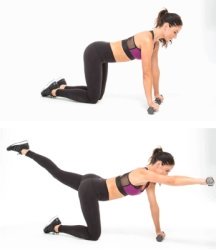
How to do the Alternating Leg/Arm Lift
- Get down on the mat on your knees and hands (in a doggy style position).
- Your hands should be shoulder width apart. Be sure to keep your back straight.
- Raise your left leg at the same time you raise your right
- Extend them straight back (leg) and in front of you (arm).
Your body should form a straight line from finger tips to toes.
- Hold that position for a second.
- Return to starting position and repeat using the right leg and left arm.
- Repeat this for several repetitions remembering to alternate legs and arms.
Whenever doing any lower back exercises, be sure to maintain proper positioning. If you start to feel undue stress and pain in your back, stop and stretch it out for a bit. If you squeeze your buttocks while in the raised position, you can also tighten and tone the glutes
Superman Back Exercise
This lower back strengthening exercise gets its name because you look as if you are flying...like superman. While this one targets the lower back, it also works the entire back region. So it's a great overall back workout. This lower back strengthening exercise is often considered a stretch, versus a strengthening move. However, since you are doing several repetitions, instead of holding for 30 or so seconds, it is classified as an exercise.
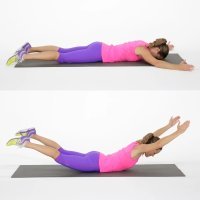
How to do the Superman Exercise
- Start by laying down flat on the floor face down.
- Reach both arms out in front of you and extend your legs out behind you.
- Raise your arms, chest and legs simultaneously off the mat.
- Contract the muscles and hold the position for a second.
- Return to starting position.
- Do 10 to 20 repetitions.
You can do this as an alternating lower back strengthening exercise as well. To do this as an alternating exercise, simply lift one leg and the opposite arm at the same time while raising your chest off the mat. Repeat with the opposite leg and arm.
Dorsal Raise
This next lower back strengthening exercise, called the dorsal raise, is a back extension exercise which targets the extensor muscles on either side of your spine. The extensor muscles enable standing and lifting of objects. They are attached to the back of the spine and include the large muscles in the lower back called the erector spinae. This muscles consists of lots of fibers that are very close to the spine.
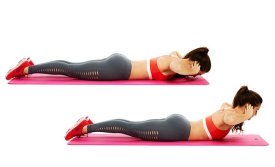
How to do the Dorsal Raise
- Lay face down on the exercise mat.
- Bend your elbows and place your finger tips at your temples with your elbows out to your sides.
- Slowly lift your chest and stomach up off the floor. Make sure to keep your hips and legs against the mat and keep them still.
- Hold this position for a few seconds and return to starting position.
- Repeat this for 10 - 20 repetitions.
To add additional resistance and for greater strengthening, place your arms directly out in front of you. Lift up off the mat (chest and stomach only) and hold. This is another exericse which is often referred to as a back stretching exercise. However, you will be engaging the muscles and therefore strengthening them.
Reverse Leg Raise
This is not the same as a straight leg raise that you do for the abdominal muscles. Instead of lying on your back, you will be lying on your stomach. Basically, you are starting in the opposite, or reverse, position for this lower back strengthening exercise.
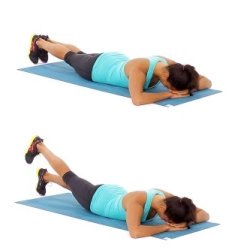
How to do the Reverse Leg Raise
- Start by lying face down on the exercise mat.
- Reach your arms straight out above your head with palms on the floor or place your hands underneath your forhead for better support.
- Make sure your legs are fully extended and are close together but not touching. They should not be wider than shoulder width apart.
- Keep your head facing down. Don't lift up while you lift your legs.
- Lift your left leg as high as you can and hold for a second.
- Return to starting position and repeat with the other leg making sure to keep your upper body flat on the floor.
- Repeat for 10 - 20 reps.
By lying face down and lifting the leg, you are engaging the lower back muscles. This is what helps strengthen this area and minimize back pain and injury. Additional muscles that will be strengthened include the glutes (or your buttocks) and your legs to a lessor degree.
Bridge Lift
The bridge lift is more of a lower body exercise versus just a back strengthening exercise. However, this version, with the straight legs, will engage more of the lower back than with the bent knees. So while this is not a typical bridge exercise, it does work the same muscles as a normal lift. These muscles are the glutes, hamstrings, abominals and of course the lower back.
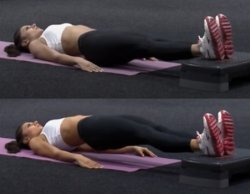
How to do the Bridge Lift
- Lie down flat on your back with your heels on the stepper.
- Keep your feet and knees together.
- Place your arms at your sides with the palms down on the floor.
- Pushing through your heels, lift your butt up off the mat keeping your shoulders on the mat.
- Squeeze the glutes while in the lifted position. Hold for a second and then return to starting position.
- Repeat for 10 - 20 repetitions.
If you don't have a stepper, do this lower back strengthening exercise by placing your feet on the floor and legs bent. You can place a towel between your knees to ensure they stay together.
In addition to these lower back strengthening exercises, try these abdominal crunches to work other areas of your core muscles.
Featured Articles
Additional Articles
Back Stretching Exercises
Strengthening your back is only one step to helping minimize back injury. You
also want to stretch and lengthen the back muscles with back stretching
exercises.
Abdominal Exercises
In addition to strengthening the lower back, you want to also strengthen your core muscles. Find out which abdominal exercises are the best with this article.
Strengthening Exercises for Seniors
Check out these fitness videos to strengthen your body to keep it
feeling and looking young.



